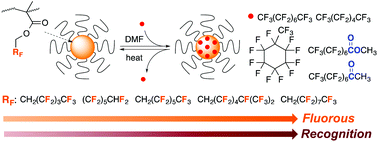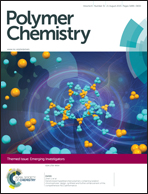Fluorinated microgel star polymers as fluorous nanocapsules for the encapsulation and release of perfluorinated compounds†
Abstract
Fluorinated microgel star polymers were designed and synthesized as fluorous nanocapsules for the encapsulation and release of perfluorinated compounds. Five types of these fluorous star polymers were obtained by ruthenium-catalyzed linking reaction of chlorine-capped poly(methyl methacrylate) arms (macroinitiators) with a perfluorinated dimethacrylate linker and a perfluorinated methacrylate (RFMA), so as to tune the in-core fluorous properties depending on the latter's structure and fluorine content. 19F nuclear magnetic resonance and 19F spin–spin relaxation time (T2) measurements revealed that the mobility of the in-core perfluorinated pendants derived from RFMA decreased on increasing the number of fluorine and carbon atoms, or the pendant length. The cores effectively recognized and encapsulated perfluorinated guest compounds (e.g., perfluorooctane and perfluoromethylcyclohexane), and the encapsulation depended on the fluorous properties of the structures and fluorous nature of RFMA and the guests. For example, encapsulation was promoted by increasing the number of in-core fluorine and CF3 groups, and typically the core with perfluorodecyl pendants successfully captured perfluorinated esters and ketones. In addition, fluorinated star polymers could reversibly capture and thermo-responsively release a perfluorinated guest, indicating that the encapsulation is selective but dynamic and stimuli-responsive.

- This article is part of the themed collection: Emerging Investigators

 Please wait while we load your content...
Please wait while we load your content...